
|
|

March 27, 2009
KGB and KOGO, San Diego
After our sojourn south of the border back in April 2008, we had one more morning remaining in "America's Finest City," San Diego - and in the course of just a few hours, we got to see both some of the newest and some of the most historic broadcast facilities in town, all thanks to a chance e-mail from one local engineer and broadcast historian. That would be Scott Rice, who was then with Clear Channel's San Diego cluster, and it's a good thing we hooked up with him when we did, because he's since returned to his east Texas to become chief of a three-FM cluster in the Tyler-Longview market.
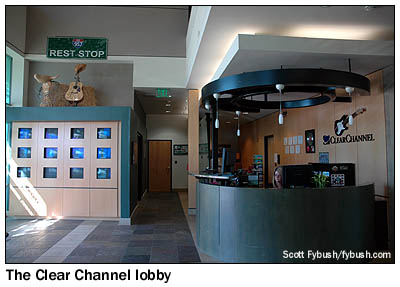
|
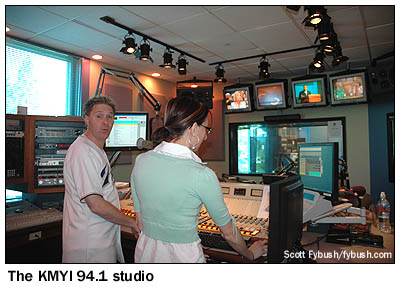
|
We met up with Scott at Clear Channel's studios at 9660 Granite Ridge Drive, amidst the office-park sprawl just north of Qualcomm Stadium. Clear Channel moved all of its stations under a single roof here in 2001, and for a time there were more stations at this address than at any other in America, thanks to a clever end-run around multiple ownership laws that found Clear Channel at least briefly owning seven stations with US licenses, operating an eighth US-licensed station (KSDO 1130), and operating five more with Mexican licenses.
A change in the interpretation of ownership rules forced Clear Channel to divest its Mexican interests not long after the move here, and there's now a wall running through part of this facility that separates those studios - now operated by competitor Finest City Broadcasting, which took control of XHITZ (90.3), XETRA-FM (91.1) and XHRM (92.5) - from Clear Channel's remaining stations. (There's now a separate door in the back of the building to enter the Finest City part of the building, which we didn't get to see this trip.)
When we visited, those included two AMs - news-talk KOGO (600) and sports KLSD (1360) - and five FMs, top 40 KHTS (93.3 El Cajon), hot AC "Star" KMYI (94.1), country KUSS (95.7 Oceanside), classic rock KGB (101.5) and active rocker KIOZ (105.3), all strung out along two hallways in the middle and back of the building in a fairly typical modern cluster layout.
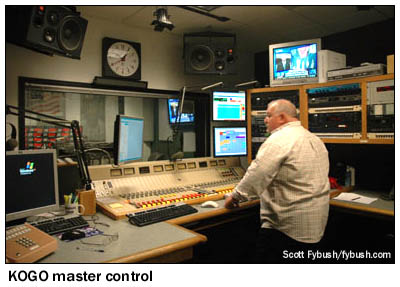
|
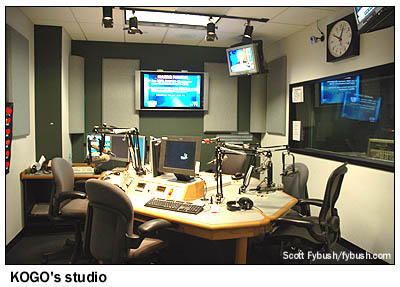
|
We didn't spend too long at the studios, because all the history here - and there's lots of it - is at two of Clear Channel's transmitter sites just a few miles to the southeast.
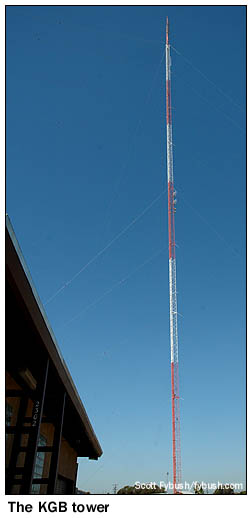
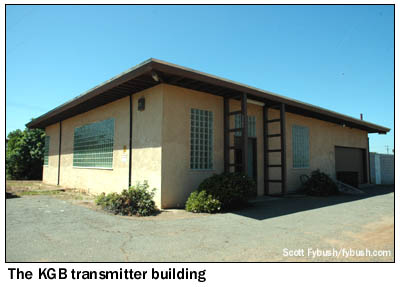
We start our transmitter tour at 2302 52nd Street, at the transmitter building that was built for KGB (1360) in the early fifties, after the station had moved from its longtime studio and transmitter home at the Pickwick Terminal Hotel downtown.
It wasn't long after KGB's move to this site that the station began rocking, becoming one of the most prominent West Coast top-40 signals of the sixties and seventies, always in tough competition with rival KCBQ (1170), though both stations would long remain limited by their signals - KCBQ with a tight nighttime directional pattern from its transmitter to the east in Santee, while KGB's big 5 kW nondirectional signal by day was reduced to a night signal of just 1000 watts, albeit nondirectional at least.
KGB-FM (101.5) came along later in the fifties, and it picked up the rock banner in the seventies as the AM signal began to flounder. By 1982, the KGB calls were gone from AM 1360, which became KCNN, KPQP, KPOP and eventually today's KLSD, first with progressive talk and then with sports.
A third FM arrived here just after the turn of the century, as Clear Channel moved KHTS (93.3 El Cajon) here from a prior transmitter site on Mother Miguel Mountain to the southeast, significantly improving that station's signal over much of the San Diego market.
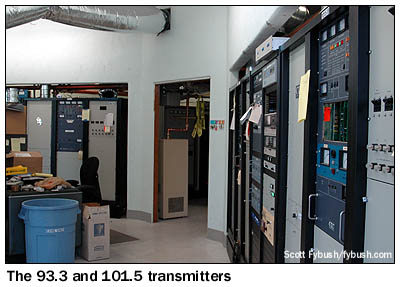
|
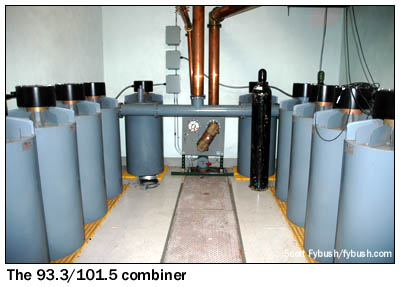
|
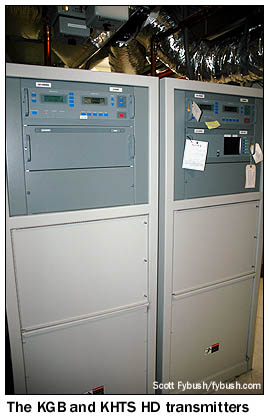
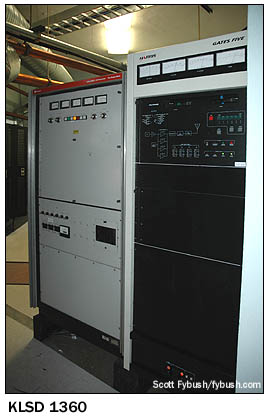 The current tower
here is 577 feet tall, crowned by a master antenna that's fed
by both KHTS and KGB's transmitters - Continentals for analog,
Harris for digital.
The current tower
here is 577 feet tall, crowned by a master antenna that's fed
by both KHTS and KGB's transmitters - Continentals for analog,
Harris for digital.
For AM 1360, the upper half of the tower is detuned, leaving a half-wave radiator below, fed by a Gates Five inside, backed up by an older Collins Power Rock.
At one time, this building must have presented an impressive appearance to visitors, with its old RCA transmitters on either side of a door leading to the back rooms. Now those walls are filled by the Continental FM transmitters, with the AM boxes, the FM HD, the combiner, and an old RCA FM backup transmitter filling the spaces behind.
And we can't leave the corner of 52nd and Kalmia without noting an interesting irony: after KGB's old rival, KCBQ, lost its Santee transmitter site to development (a Lowe's hardware store) a few years ago, KCBQ - now a religious station owned by Salem - ended up finding a temporary home right here at the KGB site, operating into a drop-wire antenna hung from insulators on one of the tower's guy wires. It has since moved again, and now diplexes with KECR (910 El Cajon) on a site far to the east of San Diego.
(I should note, too, that 1360 itself had an application a few years back to increase power to 50 kW, diplexing on the KSDO 1130 site in Santee; that application was recently dismissed at Clear Channel's request.)
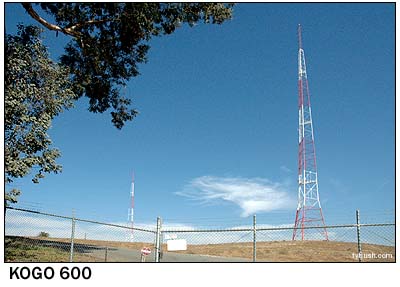
|
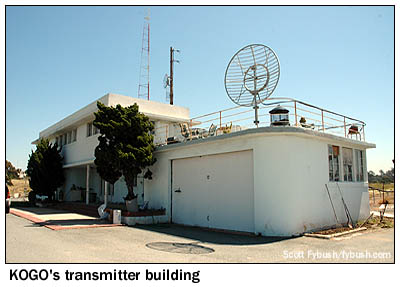
|
And our final stop on this leg of the trip finds us just a mile or so away from the KGB site, at the transmitter facility known as "Emerald Hills," home to KOGO (600), KLNV (106.5) and KSON-FM (97.3).
This facility takes its name from a country club that used to occupy this hilltop overlooking Highway 94 east of downtown San Diego. The site was purchased in 1939 for what was then KFSD on 600, but it took nearly another decade for the station to make the move from the U.S. Grant Hotel downtown out here.
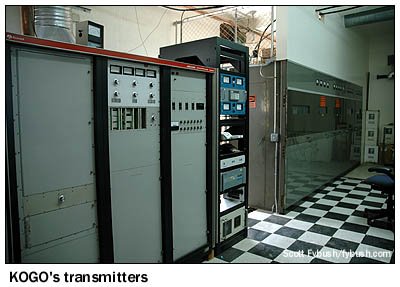
|
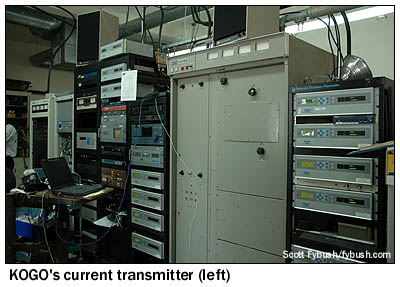
|
The plant was state-of-the-art for 1948, from the swoopy Art Deco exterior (complete with a nice patio over the garage, for the enjoyment of the engineers living in the upstairs apartment) to the even swoopier, even Art Deco-er RCA BTA-5F transmitter, still in place as an auxiliary for the station, which runs off a Gates Five and a Harris DAX that are inconspicuous by comparison. (You can see them on the left of that row of transmitters and STL relays above.)
Over the years, the KFSD callsign on 600 gave way to KOGO, then KLZZ, then KKLQ, then back to KOGO; the station also spawned sister facilities on FM (KFSD-FM 94.1, now KMYI) and TV (KFSD-TV 10, later KOGO-TV and now KGTV, with studios just down Highway 94.)
Ironically, the two FMs that now call this site home were never historically associated with KFSD/KOGO. Lincoln Financial Media's KSON-FM (97.3) is in the old garage, while Univision Radio's KLNV (106.5, which was associated with 600 in the KLZZ/KKLQ days) is in the big transmitter room with the RCA. Each FM station here has its own antenna, one atop each of the 416' Ideco self-supporting towers that crown the hilltop, with its magnificent view west to downtown and the ocean beyond.
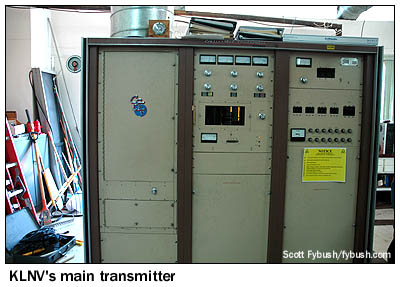
|
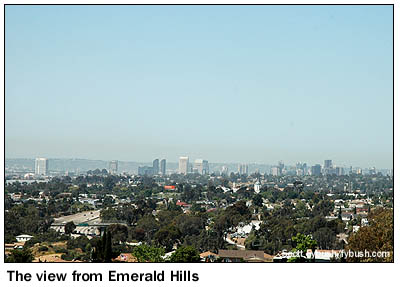
|
There's one more treat awaiting us in San Diego before we part ways with Scott Rice and head north toward Palm Springs, our destination for the evening: a peek at some of Scott's amazing collection of vintage broadcast gear, lovingly saved from dumpsters all over the Southland.
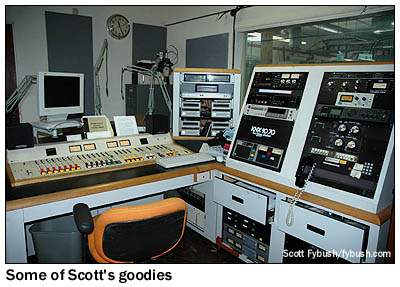
|
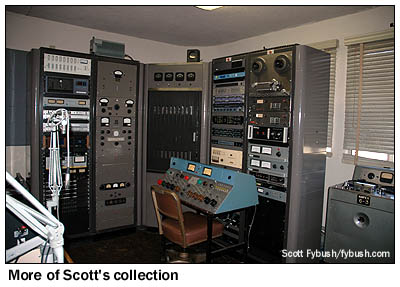
|
Scott's love of classic gear is obvious here, in a room that's been built out into a fully-functional studio, complete with a vintage RCA M-series transmitter, lots of processing, cart machines, even consoles and furniture. There are multitrack tape machines that came out of Hollywood recording studios - and yes, Scott can tell you which classic albums were recorded on each ones - and if that beautiful RCA console above looks familiar, it should: it was Rick Dees' board at one point!
- Previous Site of the Week: From Tijuana to Rosarito Beach, Mexico
- Next Week: Palm Springs, California and vicinity
- Site of the Week INDEX!
- How can you help support Site of the Week? Click here!
- Submit your suggestions for a future Site of the Week!
